International Journal of Environment, Agriculture and Biotechnology


Vol-8, Issue-2; Mar-Apr, 2023
Journal Home Page Available: https://ijeab.com/ Journal DOI: 10.22161/ijeab Peer Reviewed

International Journal of Environment, Agriculture and Biotechnology


Vol-8, Issue-2; Mar-Apr, 2023
Journal Home Page Available: https://ijeab.com/ Journal DOI: 10.22161/ijeab Peer Reviewed
Environmental Engineering Institute, Viet Nam Maritime University, Vietnam
Received: 15 Mar 2023; Received in revised form: 15 Apr 2023; Accepted: 23 Apr 2023; Available online: 30 Apr 2023 ©2023 The Author(s). Published by Infogain Publication. This is an open access article under the CC BY license (https://creativecommons.org/licenses/by/4.0/).
Abstract Bi25FeO40/g-C3N4 composites were synthesized for dechlorination of 2-chlorophenol (2-CP). The characteristic of the obtained products was studied using the X-ray diffraction (XRD), (FESEM) scanning electron microscopy, UV-vis reflectance. The effects of g-C3N4 content, photocatalyst dosage, solution pH, H2O2 on the dechlorination efficiency were investigated, in addition to the reusability of the nanocomposites. The results showed that increasing content of Bi25FeO40 in nanocomposites, from 10 to 30 wt.%, greatly increased the dechlorination efficiency Bi25FeO40/g-C3N4 20wt.% and initial pH below 6.0 was the optimal conditions for the catalytic dechlorination of 2-CP. About 94.5% of 2-CP were completely removed after 150 minutes reaction at initial pH value of 6.0. The composites were easily separated from the solution by an applied magnetic field. The removal efficiency of 2-CP slightly decreased to 90% when the catalyst was reused in 4 runs. Therefore, Bi25FeO40/g-C3N4 composites can be considered as a promising method for remediation of pollution by 2-CP.
Keyword Bi25FeO40; photo-Fenton; Cluster microspheres.
Recently, great attention has been paid for the morphology control of nanometer- and micrometer-size catalyst materials because of their interesting physical and chemical properties. Then, these materials can using widely in practice fields [1-3]. In this respect, a great number of remarkable approaches have been studied to controllingsynthesis the morphologies and facets exposed, wether in nanoscale or microscope [4, 5].
Recently, 2-chlorophenol is widely used in daily chemical and pharmaceutical industries. It is also a significatn intermediate of some medicines. Therefore, 2CP causes the serious pollution in industrial wastewater. Some catalysts prepared from precious metals and their alloys have been applicated to remove 2-CP. However, noble metals are expensive cost. To solve this problem, catalysts based on metals and their alloys as Fe, Cu and Bi were developed due to their earth-abundant, low-cost and less toxic. For example, the magnetically recyclable Bi/Bi25FeO40-C nanocomposites were prepared via a one stephydrothermalmethod andexhibitedhighphotocatalytic activity in hydrogen generation. Magnetic Bi25FeO40-
ISSN: 2456-1878 (Int. J. Environ. Agric. Biotech.)
https://dx.doi.org/10.22161/ijeab.82.15
graphene photocatalysts were fabricated by alkaline hydrothermal approach and showed enhanced catalytic activity for the removal of methylene blue (MB) under visible-light irradiation [6]
Due to the interesting characteristic, g-C3N4 is considered to be the most stable allotrope among various carbon nitrides under ambient conditions. Because of the two-dimensional frameworks of tri-s-triazine connected via tertiary amines structure , g-C3N4 possess high stable thermal and chemical stability. G-C3N4 is founded to be a visible-light-active polymeric semiconductor with a band gap of ∼2.7 eV, corresponding to an optical wavelength of ∼460 nm. Specially, it have an appropriate band structure for both water reduction and oxidation. As such, g-C3N4 is considered become the shining star in the field of photocatalysis.
In this work, Bi25FeO40/g-C3N4 composites were synthesised through a simple hydrogenthermal method.The catalyst activity of Bi25FeO40 photocatalysts were investigated by the photo-degradation 2-CP under visible light. The factors influential to the efficiency of the photodechlorination process are also studied and discussed in
detail as the effects of g-C3N4 content, photocatalyst dosage,solutionpH.Theresultshowthat Bi25FeO40/g-C3N4 composites can be considered as a promising approach for 2-CP removal.
Pure g-C3N4 powder was prepared using melamine as a precursor at 550 0C for 4h in a muffle furnace. The obtained products were washed several times with deionized water then grounded for further use. Microsphere Bi25FeO40 was synthesized via a normal hydrothermal process. In a typical procedure, a certain amount of Fe(NO3)3·9H2O (2,04 g ) and Bi(NO3)3·5H2O (2,62 g) were dissolved in 60ml of deionized water under magnetic stirring. The precipitate was put into a Teflon-lined autoclave, followed by adding with 10 mL of sodium alginate solution (10 g/L), 4.5g of citric acid and a certain amount of KOH. After 30 min ultrasonic treatment, the mixture was transfered into a Teflon liner of 100mL capability.The autoclave was sealed and heated at 180℃for 12h and cooled to room temperature naturally.The resulting precipitantwasrecoveredbyfiltration,followedbywashing with distilled water three times, and drying at 80℃ for 10h.
The Bi/g-C3N4 composite was prepared by simple impregnation method. A mount of 0.5 g Bi25FeO40 was added into 50 ml of ethanol under ultrasonic treatment for 40 min. Then, a certain amount of g-C3N4 added into the Bi25FeO40 suspension under vigorously stirring for 5 hours. The mixture was separated from the solution by an internal magnet, then washed and dried at 1000C for 12h in an electric oven. The as-prepared composites were named x% Bi/g-C3N4 (x% denotes t mass percentages of g-C3N4 in as obtained-composites). In this work, Bi/g-C3N4 composite with 10 wt%, 20 wt% and 30 wt% of g-C3N4 were synthesized, respectively.
2.2 Characterization
X-ray diffraction (XRD analysis was carried out an X-ray powder diffractometer with Cu Kα radiation at 40 kV and 40 mA. The morphology and internal structure of the prepared samples were further checked by transmission electron microscopy (FESEM), using a JEM 2100F electron microscope operated at a voltage of 200 kV. UV–vis reflectance spectraof thepowder catalysts were recorded by a Perkin Elmer spectrometer Lambda 35 using an RSAPE20 reflectance spectroscopy accessory (Labsphere Inc., NorthSutton, NH). The PL spectra of products were measured by a transient fluorescence spectrometer (Shimadzu RF-5301PC).
2.3 The photo-degradation of 2-CP
The degradation experiments were carried out under single wavelength light (PL-LED 100F λ=410 nm). 2-CP were used as the model pollutant to evaluate the Fenton activity of the Bi/gC3N4 composites In a typical process, 10 mg of Bi/gC3N4 composite was added into 100mL of the 2CP (10mg/L) aqueous solution with countinuous stirring. Before illumination, the suspension was stiring in dark for 30 minutes to reach adsorption-desorption equilibrium. Then 0.1ml of the H2O2 aqueous solution (30%) was added to the reaction solution at the beginning of the illumination. About 5ml of the suspension were collected after a defined time and centrifuged toremove the photocatalyst for UV-vis spectrum measurement.

Fig.1 shows X-ray diffaction pattens of g-C3N4, Bi25FeO40 and Bi/gC3N4 20% wt. The patterns showed the sharp and intense peaks indicating the photocatalysts were well crystallized.As shown in the Fig 1, the XRD peaks of the Bi25FeO40 were observed agree with the sillenite-type structure (JCPDS 46-0416). The strong and sharp diffraction peaks signify exbihite the high crystallinity of Bi25FeO40. The two characteristic peaks of g-C3N4 at 13.28 and 27.33 can be indexed to (100) and (002) diffraction planes (JCPDS 87-1526) [7, 8]. Compared to pure g-C3N4, it can be seen clearly most peaks for Bi25FeO40/g-C3N4 indexing to the structure of Bi25FeO40. Because of the presence of Bi25FeO40, the peaks of g-C3N4 became weaker. The character of g-C3N4 could not be obtained in the XRD pattern of 20% Bi/g-C3N4 composite sample could be explained by the low adding content and well dispersion of g-C3N4 powders. However, g-C3N4 can still be found in the composites due of the appearance of the peak at 270. The results suggests the composites were formed between gC3N4 and Bi25FeO40
The surface properties of Bi25FeO40 and Bi25FeO40/gC3N4 composite photocatalyst was observed using SEM method. The obtained results are depicted in Fig. 2. As shown in Fig. 2A, the material is composed of a large quantity of well-dispersed microspherical particles. These particles have uniform size and shape, most of which are spheres of 300-500 nm. From Fig. 2B, it is seen that the surface of the samples became rough when the g-C3N4 was modified with Bi25FeO40. The surface of Bi25FeO40 was cover by g-C3N4 particles. After loading with g-C3N4,
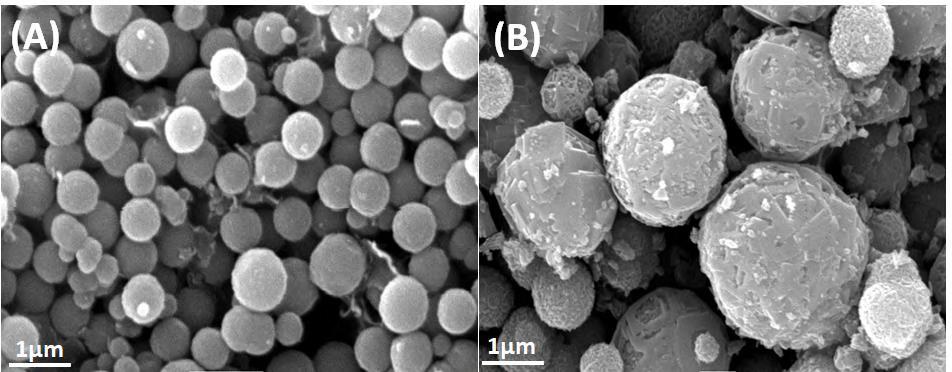
accommodation of g-C3N4 on the surface of Bi25FeO40 lead to the formation of a tight heterostructure In this case, two phases of g-C3N4 and Bi25FeO40 are clearly seen and close contact to form an intimate interface. This is similar to previous reports [9-11] It is found that cavitations created in sonochemical technique play an important role in the preparation of heterostructure materials. This can promote the formation of the stable hybrid structure between g-C3N4 and Bi25FeO40 composite [12]
The photocatalytic reaction of the Bi25FeO40/g-C3N4 catalysts were evaluated through the degradation of 2chlorophenol (2-CP) in the presence of H2O2 with visiblelight. The results of photocatalytic activities of the samples prepared at different conditions are shown in Fig. 3. When the photocatalyst is absence, no photodegradation can be observed. The photocatalytic activity of the Bi/g-C3N4 composite with visible light are further investigated by comparison with that of pure two-component. The Bi/gC3N4 composite are much more photocatalytically efficient than pure Bi25FeO40 and pure g-C3N4. As shown in Fig.3a, about 94.5 % of 2-CP is photodegraded for 150 minutes of visible light irradiation while only 31% and 42% of 2-CP reducedwith pureg-C3N4 andBi25FeO40 microspheres used, respectively
To understand the effect of g-C3N4 amount on Bi25FeO40/g-C3N4 composite, Bi/g-C3N4 10%, 20% and 30% wt composites were used for the photodegradation of 2-CP. From Fig. 3b, it can be observed that 94%, 87%, and 66% 2-CP was degraded in the present of g-CN/ZnFe 20%, 10% and 30%, respectively under the same time irradiation. It can be learned from the results that amount g-C3N4 introduced into the Bi25FeO40 is one of pivotal role for photocatalytic efficiency. When introduced g-C3N4 amount in the composites is over 30%, the photocatalytic activity is
reduced. This can be explained that with suitable content gC3N4 added, the interfacial interaction can be formed between g-C3N4 and Bi25FeO40 which resulting on the improved transfer and separation of photogenerated electron/holepairs[13].Whereas,increasingfurthercontent of g-C3N4 in the composite would form blocking on the reaction sites of Bi25FeO40 , which can make their active sites reduced [14].
The excellent photocatalytic performance of Bi25FeO40/g-C3N4 composite can be attributed to their high crystalline and hibrid structure. The tight binding of g-C3N4 and Bi25FeO40 is suitable for the charge transfer between thesetwo semiconductorsandleadsto ahighseparationrate of photogenerated electron-hole pairs while comparing to a physical mixture of two-component. As a result, these composites with a hybrid structure would result in an electric field at the interface, then improving the photocatalyticactivity. Themineralization of 2-CPwasalso investigated as depicted in Figure 3c. The results reveal that the TOC removal of 2-CP using Bi25FeO40/g-C3N4 composites as catalysts achieved about 74 %. The results suggest that as-synthesizedcluster microspheres show high capacity for the mineralization of 2-CP pollutants
Effect of catalyst amount and pH in the range of 2 to 8 on 2-CP photo-degradation efficiency was also valued as depicted in Fig. 4.Theresultsshowthatthedegradation rate
of 2-CP improved with an increase in catalyst amount, as shown in Fig. 4a. However in higher catalyst dosage, the 2CP removal percentage slightly decreased. Based on the experiment, 10 mg/L of the as-prepared composite is optimum dose for the 2-CP photo-dechlorination. The experiment results on the effect of pH reveal that the optimum pH was 6.0 (see at Fig. 4b). With pH below 6.0, in high H+ concentration, the formation of stable oxonium ion [H3O2]+ makes hydrogen peroxide more stable and then decreases its activity with ferrous ions. Moreover, the formation of Fe(II) complexes and ferric oxyhydroxides precipitation at a pH above 5.8 are probably reasons for efficiency decreases in the 2-CP removal processes.

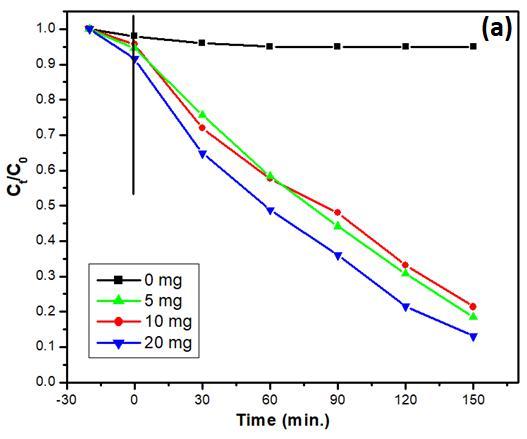
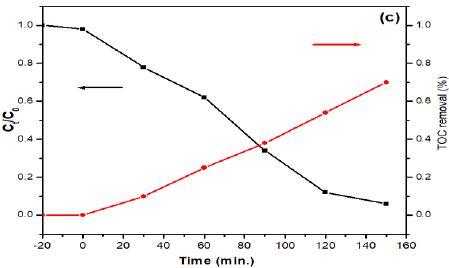

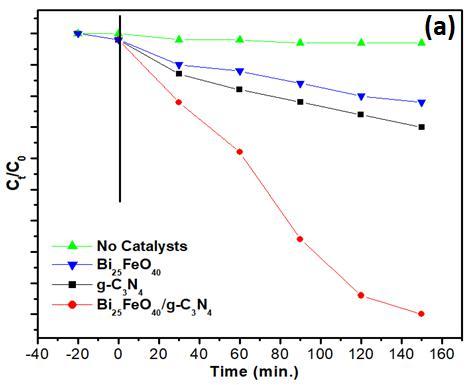
Fig. 3. (a) The 2-CP photo-degradation with different photocatalysts under visible light; (b) The 2-CP photodegradation with Bi/gC3N4 composites of 10,20,30 wt%.
(c) The mineralization of 2-CP using Bi25FeO40/g-C3N4 composite under visible light
ISSN: 2456-1878 (Int. J. Environ. Agric. Biotech.)
https://dx.doi.org/10.22161/ijeab.82.15
As known, the Fenton reaction is one of the most effective advanced oxidation processes for wastewater treatment in which the active hydroxyl radicals generated by reaction between Fe2+ and H2O2. It is reported that the presence of Fe2+ in the oxide plays an important role for the activation of H2O2[15, 16]. With the present of both visible light and H2O2, active hydroxyl radicals will be generated by main reactions following:
H2O2 + Fe (II) → Fe (Ш) + •OH + OH (3) Fe (Ш) + e- → Fe (II) (4)
Then more •OH can be produced resulting in a reaction between regenerated Fe(II) with H2O2 (Eq. (1)). Therefore, the kinetics of the reaction between •OH and 2-CP is improved remarkably via visible light irradiation[16] Moreover, the improvement of the photo-Fenton reaction of the as-prepared composite could be ascribed to the electron transfer process accelerated. As a result, the interface between Fe3+ and H2O2 improved, which result in more·OH radical from high rate of decomposition H2O2 [17]. Furthermore, the crystalline structure and hybrid structure are important factors that could improve the photocatalytic perform of the as-obtained Bi/g-C3N4
To investigate the stability of the Bi/g-C3N4 composites, the recycle tests were conducted in the oxidation process under Vis light irradiation. The results reveal that the asobtained composite was easily collected by an internal magnet and the 2-CP degradation effectively has no significant change during the 4th successive cycles, demonstrating the high stability of the composite (Fig. 5). The chracteristic plays a very important role in application for water treatment at industry scale. The high photocatalytic activity, the stability and the easily separation suggest that the Bi/g-C3N4 can be promising candidates for the 2-CP dechloronation application.
[1] M.I. Ahsaan Bari, Ali Haider, Anwar Ul-Hamid, Junaid Haider, Iram Shahzadi, Ghazanfar Nazir,Anum Shahzadi, M. Imranh, Abdul Ghaffari, Evaluation of bactericidal potential and catalytic dye degradation of multiple morphology based chitosan/polyvinylpyrrolidone-doped bismuth oxide nanostructures, NanoscaleAdv., 2022,, 4 (2022) 2713-2728.
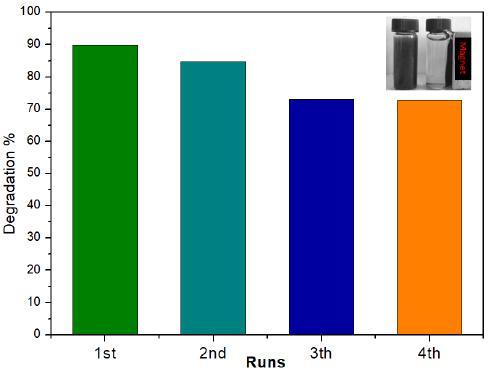
[2] S. Garg, M. Yadav, A. Chandra, K. Hernadi, A Review on BiOX (X= Cl, Br and I) Nano-/Microstructures for Their Photocatalytic Applications, J Nanosci Nanotechnol, 19 (2019) 280-294.
[3] N.A. Abdelwahab, E.M.H. Morsy, Synthesis and characterization of methyl pyrazolone functionalized magnetic chitosan composite for visible light photocatalytic degradation of methylene blue, Int J Biol Macromol, 108 (2018) 1035-1044.
[4] L. Luo, H. Lin, L. Li, T.I. Smirnova, P.A. Maggard, Copperorganic/octamolybdates: structures, bandgap sizes, and photocatalytic activities, Inorg Chem, 53 (2014) 3464-3470.
[5] U. Alam, A. Khan, D. Bahnemann, M. Muneer, Synthesis of iron and copper cluster-grafted zinc oxide nanorod with enhanced visible-light-induced photocatalytic activity, J Colloid Interface Sci, 509 (2018) 68-72.
[6] M.A. Basith, R. Ahsan, I. Zarin, M.A. Jalil, Enhanced photocatalytic dye degradation and hydrogen production ability of Bi25FeO40-rGO nanocomposite and mechanism insight, Sci Rep, 8 (2018) 11090.
[7] J. Yang, H. Chen, J. Gao, T. Yan, F. Zhou, S. Cui, W. Bi, Synthesis of Fe3O4/g-C3N4 nanocomposites and their application in the photodegradation of 2,4,6-trichlorophenol under visible light, Materials Letters, 164 (2016) 183-189.
A series of magnetic separable Bi25FeO40/g-C3N4 composite was successfully prepared by simple solvothermal method. The optimized weightratio of g-C3N4 and Bi25FeO40 was observed. The results showed that Bi25FeO40/g-CN composite with added 20% g-C3N4 exposed the highest activity for 2-CP dechlorination under visible light irradiation. The improved photocatalytic activity of 20% Bi/g-CN can be attributed to their high crystalline and hibrid structure The tight binding of g-C3N4 and Bi25FeO40 is suitable for the charge transfer between thesetwo semiconductorsandleadsto ahighseparationrate of photogenerated electron-hole pairs while comparing to a physical mixture of two-component. As a result, these composites with a hybrid structure would result in an electric field at the interface, then improving the photocatalytic activity Specially, Bi/g-C3N4 can be collected easily by using an external magnetic field and exhibite the high stability after 4 runs. These properties of the Bi/g-C3N4 composites as prepare could be a promising photokklcatalyst for the degradation pharmaceutical contaminants.
[8] J. Ma, Q. Yang, Y. Wen, W. Liu, Fe-g-C3N4/graphitized mesoporous carbon composite as an effective Fenton-like catalyst in a wide pH range, Applied Catalysis B: Environmental, 201 (2017) 232-240.
[9] X. Wang, W. Mao, J. Zhang, Y. Han, C. Quan, Q. Zhang, T. Yang, J. Yang, X. Li, W. Huang, Facile fabrication of highly efficient g-C3N4/BiFeO3 nanocomposites with enhanced visible light photocatalytic activities, J Colloid Interface Sci, 448 (2015) 17-23.
[10] T.S.Ahooie,N.Azizi,I.Yavari,M.M.Hashemi,Magnetically separable and recyclable g-C3N4 nanocomposite catalyzed one-pot synthesis of substituted imidazoles, Journal of the Iranian Chemical Society, 15 (2018) 855-862.
[11] K.Vignesh,A. Suganthi, B.-K. Min, M. Kang, Photocatalytic activity of magnetically recoverable MnFe2O4/g-C3N4/TiO2 nanocomposite under simulated solar light irradiation, Journal of Molecular CatalysisA: Chemical, 395 (2014) 373383.
[12] M. Masjedi-Arani, M. Salavati-Niasari, Cd2SiO4/Graphene nanocomposite: Ultrasonic assisted synthesis, characterization and electrochemical hydrogen storage application, Ultrason Sonochem, 43 (2018) 136-145.
[13] Y. He, L. Zhang,M.Fan, X.Wang, M.L.Walbridge, Q.Nong, Y. Wu, L. Zhao, Z-scheme SnO2 x/g-C3N4 composite as an efficient photocatalyst fordye degradation and photocatalytic
CO2 reduction, Solar Energy Materials and Solar Cells, 137 (2015) 175-184.
[14] S. Huang, Y. Xu, M. Xie, H. Xu, M. He, J. Xia, L. Huang, H. Li, Synthesis of magnetic CoFe2O4/g-C3N4 composite and its enhancement of photocatalytic ability under visible-light, Colloids and Surfaces A: Physicochemical and Engineering Aspects, 478 (2015) 71-80.
[15] X.-L. Cheng, J.-S. Jiang, D.-M. Jiang, Z.-J. Zhao, Synthesis of Rhombic Dodecahedral Fe3O4 Nanocrystals with Exposed High-Energy {110}FacetsandTheirPeroxidase-likeActivity and Lithium Storage Properties, The Journal of Physical Chemistry C, 118 (2014) 12588-12598.
[16] X. Feng, G.Y. Mao, F.X. Bu, X.L. Cheng, D.M. Jiang, J.S. Jiang, Controlled synthesis of monodisperse CoFe2O4 nanoparticles by the phase transfer method and their catalytic activity on methylene blue discoloration with H2O2, Journal of Magnetism and Magnetic Materials, 343 (2013) 126-132.
[17] P. Alimard, Fabrication and kinetic study of Nd-Ce doped Fe3O4-chitosan nanocomposite as catalyst in Fenton dye degradation, Polyhedron, 171 (2019) 98-107.
ISSN: 2456-1878 (Int. J. Environ. Agric. Biotech.)
https://dx.doi.org/10.22161/ijeab.82.15